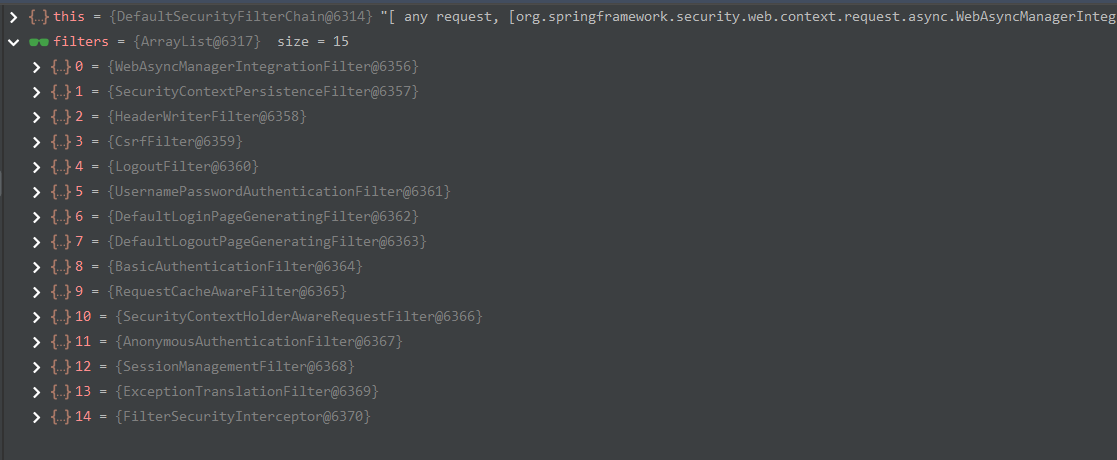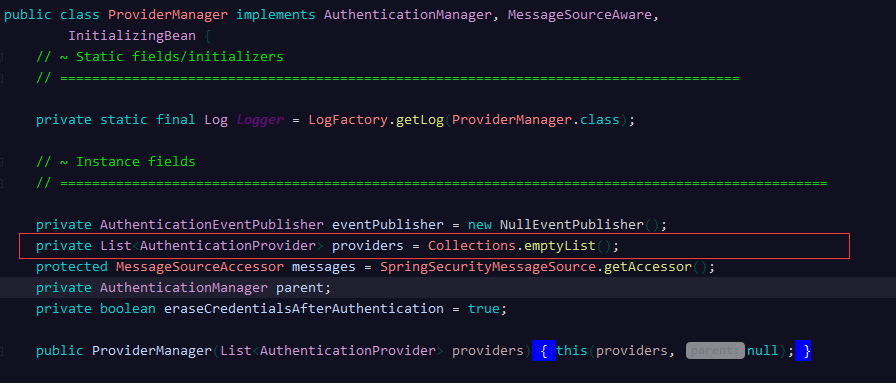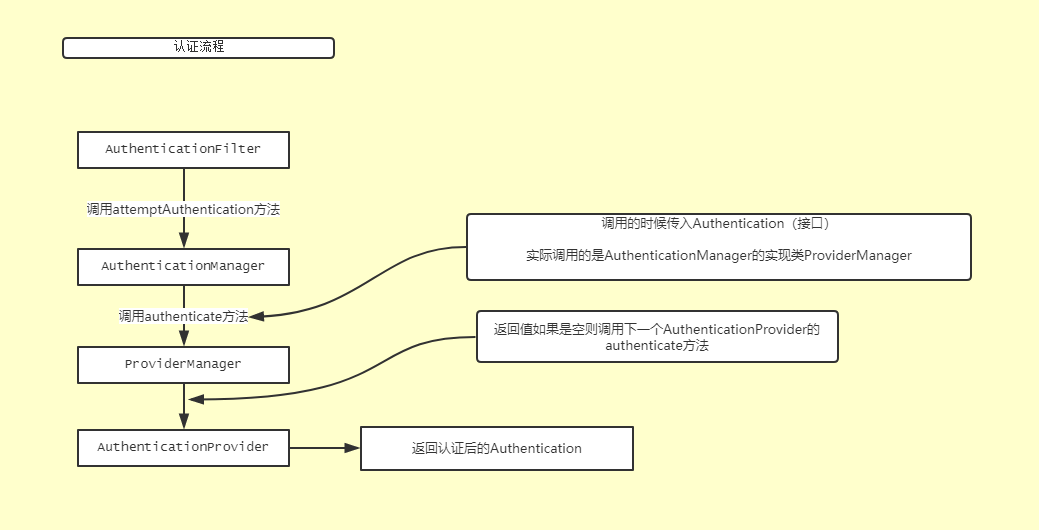Spring Security探究之路之开始
前言
在Spring Security介绍中,我们分析到了根据请求获取匹配的SecurityFilterChain,这个类中包含了一组Filter

接下来我们从这些Filter开始探究之旅
Spring Security Filter简介
AuthenticationFilter中的attemptAuthentication方法调用AuthenticationManager(interface)的authenticate方法,AuthenticationManager的实际是现实ProvideManager
ProviderManager 有一个配置好的认证提供者列表(AuthenticationProvider), ProviderManager 会把收到的 UsernamePasswordAuthenticationToken 对象传递给列表中的每一个 AuthenticationProvider 进行认证.

认证过程
AuthenticationProvider接口
public interface AuthenticationProvider {
// ~ Methods
// ========================================================================================================
/**
* Performs authentication with the same contract as
* {@link org.springframework.security.authentication.AuthenticationManager#authenticate(Authentication)}
* .
*
* @param authentication the authentication request object.
*
* @return a fully authenticated object including credentials. May return
* <code>null</code> if the <code>AuthenticationProvider</code> is unable to support
* authentication of the passed <code>Authentication</code> object. In such a case,
* the next <code>AuthenticationProvider</code> that supports the presented
* <code>Authentication</code> class will be tried.
*
* @throws AuthenticationException if authentication fails.
*/
Authentication authenticate(Authentication authentication)
throws AuthenticationException;
/**
* Returns <code>true</code> if this <Code>AuthenticationProvider</code> supports the
* indicated <Code>Authentication</code> object.
* <p>
* Returning <code>true</code> does not guarantee an
* <code>AuthenticationProvider</code> will be able to authenticate the presented
* instance of the <code>Authentication</code> class. It simply indicates it can
* support closer evaluation of it. An <code>AuthenticationProvider</code> can still
* return <code>null</code> from the {@link #authenticate(Authentication)} method to
* indicate another <code>AuthenticationProvider</code> should be tried.
* </p>
* <p>
* Selection of an <code>AuthenticationProvider</code> capable of performing
* authentication is conducted at runtime the <code>ProviderManager</code>.
* </p>
*
* @param authentication
*
* @return <code>true</code> if the implementation can more closely evaluate the
* <code>Authentication</code> class presented
*/
// 支持的Authentication(interface)
/**
|-Authentication
|--UsernamePassowrdAuthentication
|--CasAuthentication
|-- ...........
**/
boolean supports(Class<?> authentication);
}
ProviderManager的authencate方法:
// 依次调用AuthencationProvider
public Authentication authenticate(Authentication authentication)
throws AuthenticationException {
Class<? extends Authentication> toTest = authentication.getClass();
AuthenticationException lastException = null;
Authentication result = null;
boolean debug = logger.isDebugEnabled();
// 遍历 AuthenticationProvider
for (AuthenticationProvider provider : getProviders()) {
// 当前的AuthenticationProvider是否支持Authentication
if (!provider.supports(toTest)) {
continue;
}
if (debug) {
logger.debug("Authentication attempt using "
+ provider.getClass().getName());
}
try {
result = provider.authenticate(authentication);
// 认证结果中如果不为null(验证成功),则遍历结束,拷贝认证后的结果到authentication对象
if (result != null) {
copyDetails(authentication, result);
break;
}
}
catch (AccountStatusException e) {
prepareException(e, authentication);
// SEC-546: Avoid polling additional providers if auth failure is due to
// invalid account status
throw e;
}
catch (InternalAuthenticationServiceException e) {
prepareException(e, authentication);
throw e;
}
catch (AuthenticationException e) {
lastException = e;
}
}
if (result == null && parent != null) {
// Allow the parent to try.
try {
result = parent.authenticate(authentication);
}
catch (ProviderNotFoundException e) {
// ignore as we will throw below if no other exception occurred prior to
// calling parent and the parent
// may throw ProviderNotFound even though a provider in the child already
// handled the request
}
catch (AuthenticationException e) {
lastException = e;
}
}
if (result != null) {
if (eraseCredentialsAfterAuthentication
&& (result instanceof CredentialsContainer)) {
// Authentication is complete. Remove credentials and other secret data
// from authentication
((CredentialsContainer) result).eraseCredentials();
}
eventPublisher.publishAuthenticationSuccess(result);
return result;
}
// Parent was null, or didn't authenticate (or throw an exception).
if (lastException == null) {
lastException = new ProviderNotFoundException(messages.getMessage(
"ProviderManager.providerNotFound",
new Object[] { toTest.getName() },
"No AuthenticationProvider found for {0}"));
}
prepareException(lastException, authentication);
throw lastException;
}

授权
前面有filter处理了登录问题,接下来是否可访问指定资源的问题就由FilterSecurityInterceptor来处理了。而FilterSecurityInterceptor是用了AccessDecisionManager来进行鉴权。
来看看他干了什么
/**
* Method that is actually called by the filter chain. Simply delegates to the
* {@link #invoke(FilterInvocation)} method.
*
* @param request the servlet request
* @param response the servlet response
* @param chain the filter chain
*
* @throws IOException if the filter chain fails
* @throws ServletException if the filter chain fails
*/
public void doFilter(ServletRequest request, ServletResponse response,
FilterChain chain) throws IOException, ServletException {
FilterInvocation fi = new FilterInvocation(request, response, chain);
invoke(fi);
}
public void invoke(FilterInvocation fi) throws IOException, ServletException {
if ((fi.getRequest() != null)
&& (fi.getRequest().getAttribute(FILTER_APPLIED) != null)
&& observeOncePerRequest) {
// filter already applied to this request and user wants us to observe
// once-per-request handling, so don't re-do security checking
fi.getChain().doFilter(fi.getRequest(), fi.getResponse());
}
else {
// first time this request being called, so perform security checking
if (fi.getRequest() != null && observeOncePerRequest) {
fi.getRequest().setAttribute(FILTER_APPLIED, Boolean.TRUE);
}
// 调用前
// 该过程中会调用 AccessDecisionManager 来验证当前已认证成功的用户是否有权限访问该资源
InterceptorStatusToken token = super.beforeInvocation(fi);
try {
fi.getChain().doFilter(fi.getRequest(), fi.getResponse());
}
finally {
super.finallyInvocation(token);
}
// 调用后
super.afterInvocation(token, null);
}
}
Spring Security探究之路之开始的更多相关文章
- spring security 关于 http.sessionManagement().maximumSessions(1);的探究
1.前言 spring security 支持对session的管理 , http.sessionManagement().maximumSessions(1);的意思的开启session管理,ses ...
- spring security 4 filter 顺序及作用
Spring Security 有两个作用:认证和授权 一.Srping security 4 filter 别名及顺序 spring security 4 标准filter别名和顺序,因为经常要用就 ...
- 从源码看Spring Security之采坑笔记(Spring Boot篇)
一:唠嗑 鼓捣了两天的Spring Security,踩了不少坑.如果你在学Spring Security,恰好又是使用的Spring Boot,那么给我点个赞吧!这篇博客将会让你了解Spring S ...
- Spring Security OAuth2实现单点登录
1.概述 在本教程中,我们将讨论如何使用 Spring Security OAuth 和 Spring Boot 实现 SSO(单点登录). 本示例将使用到三个独立应用 一个授权服务器(中央认证机制) ...
- Spring Security +Oauth2 +Spring boot 动态定义权限
Oauth2介绍:Oauth2是为用户资源的授权定义了一个安全.开放及简单的标准,第三方无需知道用户的账号及密码,就可获取到用户的授权信息,并且这是安全的. 简单的来说,当用户登陆网站的时候,需要账号 ...
- Spring Security 入门原理及实战
目录 从一个Spring Security的例子开始 创建不受保护的应用 加入spring security 保护应用 关闭security.basic ,使用form表单页面登录 角色-资源 访问控 ...
- Ajax登陆,使用Spring Security缓存跳转到登陆前的链接
Spring Security缓存的应用之登陆后跳转到登录前源地址 什么意思? 用户访问网站,打开了一个链接:(origin url)起源链接 请求发送给服务器,服务器判断用户请求了受保护的资源. 由 ...
- 笔记43 Spring Security简介
基于Spittr应用 一.Spring Security简介 Spring Security是为基于Spring的应用程序提供声明式安全保护的安全 性框架.Spring Security提供了完整的安 ...
- Spring Security原理篇(一) 启动原理
1.概述 spring security有参考的中文翻译文档https://springcloud.cc/spring-security-zhcn.html 在学习spring security的时候 ...
随机推荐
- oracle 之 cursor:创建存储过程批量执行DDL语句
说明:使用此过程可任意执行批量DDL语句,调用DDL查询语句时,注意转义字符,使用 ' 转义! 需求:批量删除以CUR_TEST开头的表,且有日志记录. 环境准备:建几张以CUR_TEST开头测试表. ...
- Struts2的jsonp接口实例
和以往写struts2程序一样,action方法跳转到一个JSP中,为了配合jsonp的跨域,要在JSP中做一个输出 JSP: <%@ page language="java" ...
- Python爬取中国知网文献、参考文献、引证文献
前两天老师派了个活,让下载知网上根据高级搜索得到的来源文献的参考文献及引证文献数据,网上找了一些相关博客,感觉都不太合适,因此特此记录,希望对需要的人有帮助. 切入正题,先说这次需求,高级搜索,根据中 ...
- HDU 2099 整除的尾数(枚举 & 暴搜)
原题链接:http://acm.hdu.edu.cn/showproblem.php?pid=2099 思路分析:这道题的解法可以说是相当暴力了,但也有一些小坑,以下几点萌新们值得留意一下: 1. 仔 ...
- 论文解读DEC《Unsupervised Deep Embedding for Clustering Analysis》
Junyuan Xie, Ross B. Girshick, Ali Farhadi2015, ICML1243 Citations, 45 ReferencesCode:DownloadPaper: ...
- 《剑指offer》面试题56 - II. 数组中数字出现的次数 II
问题描述 在一个数组 nums 中除一个数字只出现一次之外,其他数字都出现了三次.请找出那个只出现一次的数字. 示例 1: 输入:nums = [3,4,3,3] 输出:4 示例 2: 输入:nums ...
- Java读取批量Excel文件
1.首先基础知识: 原文链接:https://blog.csdn.net/baidu_39298625/article/details/105842725 一 :简介 开发中经常会设计到excel的处 ...
- nodejs express异常捕获
参考链接: http://blog.coinidea.com/web开发/nodejs-1131.html 由于nodejs是非阻塞单进程单线程的,一旦nodejs抛出异常,整个服务就会停掉.服务将会 ...
- java-包与包之间的访问
1 package face_package; 2 3 import face_packagedemoA.DemoA; 4 5 /* 包(package) 6 * 1,对类文件进行分类管理. 7 * ...
- jsp中获取下拉框的value问题
遇到问题 最近快期末考试了,今天想写一个简单的增删改查项目练练手,可是在刚写增加的时候就出现了问题,"增"一直是最简单的操作,本来自付很快就能写完,可是数据库中对应的下拉框数据一直 ...
